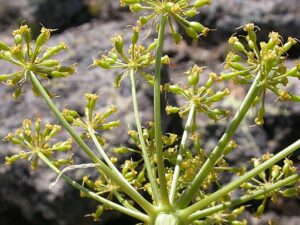
Matt Lavin from Bozeman, Montana, USA, CC BY-SA 2.0, via Wikimedia Commons
Native Americans of many tribes reportedly used lomatium Click to listen highlighted text! lomatium root to treat a wide variety of infections, particularly those affecting the lungs. It was used, particularly in the southwestern United States, during the influenza pandemic of 1917 with reportedly good results.
The Plant
Botanical name: Lomatium dissectum. Lomatium is native to western North America. Lomatium is potentially threatened in some parts of its habitat, so it should not be picked from the wild without consulting local experts familiar with the plant. The root of lomatium is used medicinally for infection.
Active constituents in Lomatium:
According to obscure sources, lomatium is reputed to have antiviral effects. One source suggests the constituents tetronic acids and a glucoside of luteolin may be potentially antiviral. However, little is known about how these compounds act or if other ones might be as important.
Dosage:
Its extracts with the resins removed (often called lomatium isolates), 1–3 ml per day, have been recommended. The tincture, 1–3 ml three times per day, can also be used, but it may cause a rash in susceptible people. The tincture should not be used unless a very small amount of it is first tested for a reaction. However, even very small amounts can cause a reaction in sensitive people.
Precautions:
Use of the extracts or tinctures containing the resin (and possibly the coumarins) can, in some people, cause a whole-body rash. This herb may also lead to nausea in some people. The safety during pregnancy and breast-feeding is unknown and is therefore not recommended. At the time of writing, there were no well-known drug interactions.
As with any supplement, you should always check with your doctor before adding anything new to your health regiment without a prescription. Reporting vitamins, minerals, herbs, and even your diet, is important.
